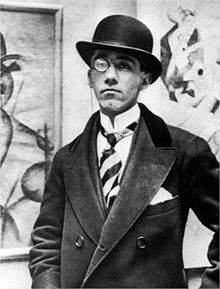Gino Severini
| Gino Severini | |
|---|---|

Gino Severini, aged 30, at the opening of his solo exhibition at the Marlborough Gallery, London
|
|
| Born |
7 April 1883 Cortona, Italy |
| Died | 26 February 1966 (aged 82) Paris |
| Nationality | Italian |
| Education | Rome Fine Art Institute |
| Known for | Painting, mosaic, fresco |
| Notable work | Pan Pan Dance, Dynamic Hieroglyph of the Bal Tabarin, Italian Lancers at a Gallop, Maternity, Conségna delle Chieve |
| Movement | Divisionism, Futurism, Cubism, Return to order, Neo-Classicism, Novecento Italiano |
| Awards | Premio Nazionale di Pittura of the Accademia di San Luca, Rome |
Gino Severini (7 April 1883 – 26 February 1966) was an Italian painter and a leading member of the Futurist movement. For much of his life he divided his time between Paris and Rome. He was associated with neo-classicism and the "return to order" in the decade after the First World War. During his career he worked in a variety of media, including mosaic and fresco. He showed his work at major exhibitions, including the Rome Quadrennial, and won art prizes from major institutions.
Severini was born into a poor family in Cortona, Italy. His father was a junior court official and his mother a dressmaker. He studied at the Scuola Tecnica in Cortona until the age of fifteen, when he was expelled from the entire Italian school system for the theft of exam papers. For a while he worked with his father; then in 1899 he moved to Rome with his mother. It was there that he first showed a serious interest in art, painting in his spare time while working as a shipping clerk. With the help of a patron of Cortonese origins he attended art classes, enrolling in the free school for nude studies (an annex of the Rome Fine Art Institute) and a private academy. His formal art education ended after two years when his patron stopped his allowance, declaring, "I absolutely do not understand your lack of order."
In 1900 he met the painter Umberto Boccioni. Together they visited the studio of Giacomo Balla, where they were introduced to the technique of Divisionism, painting with adjacent rather than mixed colors and breaking the painted surface into a field of stippled dots and stripes. The ideas of Divisionism had a great influence on Severini's early work and on Futurist painting from 1910 to 1911.
Severini settled in Paris in November 1906. The move was momentous for him. He said later, "The cities to which I feel most strongly bound are Cortona and Paris: I was born physically in the first, intellectually and spiritually in the second." He lived in Montmartre and dedicated himself to painting. There he met most of the rising artists of the period, befriending Amedeo Modigliani and occupying a studio next to those of Raoul Dufy, Georges Braque and Suzanne Valadon. He knew most of the Parisian avant-garde, including Jean Metzinger, Albert Gleizes, Juan Gris, Pablo Picasso, Lugné-Poe and his theatrical circle, the poets Guillaume Apollinaire, Paul Fort, and Max Jacob, and author Jules Romains. The sale of his work did not provide enough to live on and he depended on the generosity of patrons.
...
Wikipedia
